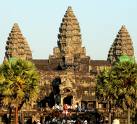
 We arose at 5 am, and in the velvety dark, made our way towards the east gate of Angkor Wat. Our passes were examined by torchlight and then we followed Dinay, our Cambodian guide towards the upper stories of the temple.
We arose at 5 am, and in the velvety dark, made our way towards the east gate of Angkor Wat. Our passes were examined by torchlight and then we followed Dinay, our Cambodian guide towards the upper stories of the temple.“Don’t look down. Just keep on going, ” said Dinay, who looked just like Tintin. If I’d wanted a gut-wrenching, heart-fluttering climb, I’d have signed up for Everest trip, I moaned to myself. Surely we could halt here. “Nice temple. Now can we go back?”
Dinay enthusiastically dragged us to the top. He had saved the best for the last. Over the previous days, he’d shown us many wondrous temples — Ta Prohm, (the one that has been left the way it was found, with the strangler fig trees still entangled in the laterite stone), Bayon (the one with dozens of giant Buddha’s heads) and Bantei Samrei (the one with exquisite carvings of scenes from the Ramayan).
We watched the sky get painted, brush-stroke by brush-stroke, as the sun climbed effortlessly into the sky. It was a truly spectacular sight.
Dinay smiled proudly and explained that the 500 acre temple complex was designed as the universe, surrounded by water. And we, like the Khmer Kings, Suryavarman and Jayavarman, were at the top of it.
Adopted faith
The history of these temples remains shrouded in mystery. Until 1860, when French archaeologist Albert Henri Mouhot discovered them, they had been completely forgotten by the world, and blanketed by the forest. We’d read that Hindu traders first impressed the Khmer kings, a thousand years ago with their advanced culture. Anthropologists have said that though the local people were not Indianized, Indian culture was localized. Scenes from the great epics are etched in relief on the stone walls. Interestingly, the word ‘Angkor’ comes from ‘nagar’ meaning city in Sanskrit.
Buddhism followed Hinduism, and the orange clad monks have taken over the daily up-keep of the temples. We watched a prayer ceremony at one of the temples, and were surprised to see, amidst the offerings of incense, fruits and sweets were pork heads, plucked chicken and a pile of cigarettes.
Beyond the temples
We were driven around the small town of Siam Reap on Dinay’s motorized rickshaw. Siam Reap, the spring-board for temple viewing, has become hugely popular with visitors and dozens of hotels, restaurants, bars and shops have come up in the last decade. Away from the usual beat, the short, swarthy, friendly but stoic Khmer folks still live in thatched homes built on stilts. Each home has a handful of banana trees, a fishing net and a resident chicken brood. The men and women wore a chequered cloth on their heads, called a krama, which can also become a belt, shawl, scarf, baby carrier or a shopping tote.
It was our last evening in Siam Reap. “Right, Dinay, should we head out towards Tonley Sap Lake, the night market and maybe stop at a cafe or two?” “Sure, we will. But first, you must come with me. I have to show you something bery bery special. Angkor Wat by moonlight.”

Be the first to comment